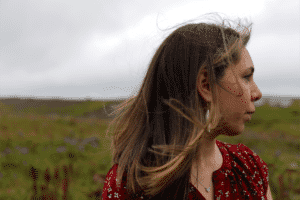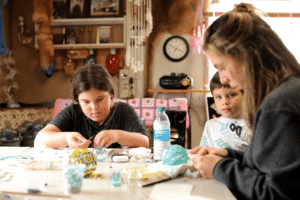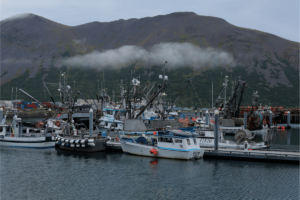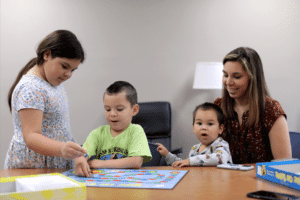Inaccessible featuring Candace Nielsen
Finding Lessons in the Everyday: Challenges of Education in the Aleutians
 Candace Nielsen’s three children rush into the room, full of smiles. She asks them about their day. “We saw five cows!” reports her elder son proudly, as he brandishes a gray plastic sword. Her younger son is slightly shy, but curiously looks around the room. The family pulls out a whiteboard and begins a language exercise.
Candace Nielsen’s three children rush into the room, full of smiles. She asks them about their day. “We saw five cows!” reports her elder son proudly, as he brandishes a gray plastic sword. Her younger son is slightly shy, but curiously looks around the room. The family pulls out a whiteboard and begins a language exercise.
“If they’re really good,” says Nielsen, “sometimes I let them get on the internet and stream a show.”
Though the scene might come from anywhere in America, it is unfolding in a place that is far from ordinary. Nielsen and her family live in Cold Bay, a community of less than one hundred located near the western edge of the Alaska Peninsula. Education in communities like Cold Bay is a constant challenge, and requires persistence, adaptability, and creativity.
“That’s the beauty of homeschool,” Nielsen explains, “that we can find learning opportunities in just everyday life activities.”
Candace grew up in Nelson Lagoon, Alaska, about 81 miles northeast of Cold Bay. She has fond memories of her childhood, lovingly recalling the close-knit family and community there. Much of her family remains in the village. But economic opportunities in Nelson Lagoon were limited, commercial salmon fishing alone could not support a
growing family. When Candace was 10, her dad moved the family to Cold Bay to take a job with the Department of Transportation. It was in Cold Bay that Candace would eventually meet her husband, Matt Nielsen.
Cold Bay has one of the largest runways in Alaska and serves as a major transportation hub for the Alaska Peninsula and Aleutian Islands region. Unlike other communities in the region, Cold Bay is not a federally recognized tribal village. Rather, it is a more officious and work-oriented place; most of the jobs are state or federal government positions.
The move wasn’t easy: Candace missed the support of family in Nelson Lagoon, and at first they felt isolated. But they adjusted to their new life, and Nielsen’s husband found a job working with the Fish and Wildlife Service. The job allows Candace to homeschool her 3 children, instead of working full-time, and provides enough income for the family to live comfortably and put away money for retirement. They have even discussed building their dream home in the future.
“We always joke that we got stuck long term, because usually when people come through Cold Bay they get stuck or weathered in. But we’re still stuck,” she says with a bright laugh. “But it’s been great!”
In Cold Bay, Candace works part-time as the Cultural Community Liaison for the Aleutian Pribilof Island Association, volunteers at the library, and serves on the city council. She is also the former mayor of Cold Bay, having served a two-year term from 2014-2016. She is interested in politics, and contemplates the idea of running for office in the future—perhaps for State House. She is excited by the sudden political popularity of Mary Peltola, a fellow Alaska Native woman, who is currently running for U.S. Congress. The idea that an Alaska Native woman could hold such a prominent office would have felt like a fantasy just a generation ago. Now, it may become a reality.
“It’s been a dream of mine,” Candace says. “I’ve always enjoyed politics and speaking up for the people and communities in the region.”
But when she became pregnant with their first child Brooke, she decided that the most important position she could hold—at least for the time being—was that of a mother. And in a place like Cold Bay, that now means homeschooling.
By law, the State of Alaska must provide a teacher to a community that has ten or more school-age children. In small communities like Nelson Lagoon or Cold Bay, this cutoff can cause significant anxiety when the population of school-age children nears or dips below the ten-student threshold.
For years, enrollment at the state school in Nelson Lagoon fluctuated and then dropped below the cutoff and remained there. Their last high school student graduated, but the school shut down in 2012.
“That was a tremendous loss for the community,” Candace recalls, “and for all of us that grew up in that school to see it get boarded up, and gutted. That was difficult, to say the least.” She feared that the closure of the school would devastate the community.
“It was like my entire childhood was being ripped away from me, and I wasn’t going to be able to give that to my kids,” Candace says. “I’ve since recovered!” she adds, with a laugh.
Then the same thing happened at Cold Bay. The number of school-age children dropped to six students, and the State told them that a school closure might be on the table. The community pointed out that the school had served as a shelter for passengers whose planes were diverted to Cold Bay and grounded due to emergencies. The community also fought to secure other sources of funding.
But despite their best efforts, the school board decided to close the school in 2014.
“It was a gut punch,” Candace says. “Heartache.”
After the school closed, Candace and the other parents experimented with collaborative schooling for their children, but it was difficult to align curricula and schedules. Eventually, it became clear that her best option was homeschooling.
The prospect of being a mother, while also learning to be a teacher, was daunting. But Candace approached the job with the same zeal that she had brought to her other positions in the community. She studied and read extensively about teaching methods, and worked hard to find and use the resources available to parents who homeschool.
The State provides financial support and other resources for homeschooling, including a statewide correspondence program that Candace’s children are enrolled in. Homeschooling also provides Candace an opportunity to educate her children through the lens of traditional knowledge. Her grandma, she explains, warned her children and grandchildren not to acknowledge their Native ancestry and did not pass on language or traditions because of concerns about rampant racism and discrimination.
Homeschooling allows Candace to partially correct that loss of culture, and she is able to incorporate Unangax̂ language, arts, subsistence, and other culture into lessons.
“I am Unangax̂,” Candace says. “I was raised in the region. We lived off the land. So that to me is the biggest chunk of knowledge. Understanding the land, the weather, the sea, and working it.”
Still, there are challenges. Broadband is extremely expensive and slow, which complicates distance learning. Candace acknowledges that there is an upside to the limited access: “There really is a beauty to not having the connectivity,” she says, “Because I’m not losing my kids to the internet. They’re not streaming YouTube all day long and playing games.”
But the consequences for distance learning are significant. The family could easily spend their entire allotment for internet access in three months, she says. The lack of access means that her children have limited opportunities to learn remotely with children from other communities. The slow internet speeds, she explains, can make it feel like they are “living in the past.”
And, of course, the children occasionally say that they wish they had more classmates to play with.

![]() Candace believes that Alaska’s state government should do more to provide educational opportunities to Cold Bay, particularly because the community provides so many benefits to the State. Because of its large World-War II-era runway, the community is the regional transportation hub for King Cove, False Pass, Sand Point, Nelson Lagoon and sometimes Unalaska. Candace would like to see more support for Cold Bay’s children, who are part of families that provide critical services and who may play a role in the long-term survival of the community.
Candace believes that Alaska’s state government should do more to provide educational opportunities to Cold Bay, particularly because the community provides so many benefits to the State. Because of its large World-War II-era runway, the community is the regional transportation hub for King Cove, False Pass, Sand Point, Nelson Lagoon and sometimes Unalaska. Candace would like to see more support for Cold Bay’s children, who are part of families that provide critical services and who may play a role in the long-term survival of the community.
She doesn’t believe that the challenges she faces with educating children in Cold Bay are unique to the community, however. “The State of Alaska does not have education as a priority for the kids,” she states bluntly.
Despite the presence of the all-weather airport, transportation is still a challenge. Candace wishes she had more funding to take her children to other communities, where they could socialize with other students and learn from individuals and cultures outside of Cold Bay. And the volatile weather in the Alaska Peninsula and Aleutian Islands means that, despite excellent pilots, weather often delays travel or prevents it altogether.
She wishes the road connecting Cold Bay and King Cove would be built. Construction of the road has been the subject of a long and bitter political fight on the local, state, and federal levels because the one-lane gravel road would have to traverse the Izembek National Wildlife Refuge, which was established in 1980 without the knowledge or input of the local tribe. Construction of a road to King Cove could allow her children to more easily interact with the larger student population in King Cove, but for now the road is still only a dream.
When her children are old enough, Candace hopes to send them to boarding school at Mt. Edgecumbe, in Sitka—following in their mother’s footsteps.
As a child in Nelson Lagoon, Nielsen had a range of experiences with teachers. Some were excellent, but others had insufficient preparation for or knowledge of what it would take to live in rural Alaska. “It sounds like a great idea and a great adventure,” she says, “until you’re in the dead of winter and going crazy because you’re just not equipped.” The community became used to teachers who got overwhelmed by the weather or culture shock, and simply left.
But things changed for Candace’s education when she left home to attend Mt. Edgecumbe boarding school for her high-school years. Her first semester was difficult: adjusting to the new people and culture created its own type of culture shock, and she was homesick. She returned to Nelson Lagoon for one semester before she was ready to give Mt. Edgecumbe another try. This time, Candace dove into the experience headfirst and excelled.
“I joined every club and I did all the activities I could do,” she says. She served on the student council, and as student body president. She was able to travel, and even learned to lobby for the school.
One of her lobbying efforts resulted in the construction of a new swimming pool.
Overall, Candace says, her experience at Mt. Edgecumbe was phenomenal. The school allowed her to develop friendships with students from around the state and prepared her for a life of civic engagement. Mt. Edgecumbe provided her with opportunities she never would have gotten if she had stayed in Nelson Lagoon, she says.
However, even the prospect of her children receiving a quality education at Mt. Edgecumbe feels uncertain. Recently, a proposal was put forward to convert Mt. Edgecumbe to a two-year vocational school. The proposal was met with strong pushback — Candace even wrote a letter condemning it — and the project was shelved. But for Candace and others in rural Alaska communities, it was a stark reminder that they can never fully take access to quality education for granted.
If her children are able to attend Mt. Edgecumbe, as she hopes, the family may reassess their living situation. Candace still visits Nelson Lagoon. She recently returned from a birthday trip there, where she was immediately pulled back into the supportive, warm embrace of her family and community.
“That’s home and where my heart is at,” she says, “but it’s not doable right now.”
For now, wherever she and her family are, Candace remains focused on her children’s education and on living Unangax̂ culture and ways of life.
Candace reminds her children “to value their elders,” she says, because it is impossible to know how much time you have left with them. Her aunt, Sharon, picked up traditional glass ball beading, a skill that Candace would like to learn for herself. “That’s an Unangax̂ strength,” she says, “that we can pick up and learn things like that.” Candace earned her Bachelor of Arts in Rural Development from the University of Alaska Fairbanks, taking advantage of their distance education program. She is proud that she was able to earn her degree, while simultaneously raising her children and serve her community.
Candace is currently working to regain traditional indigenous knowledge by participating in the University of Alaska’s Alaska Native Studies program, and has surrounded herself with Unangax̂ language speakers. All of these are things she is learning for herself—and also passing on to her children. At the end of the day, despite the challenges, the connection to land, culture, and community makes life in the Aleutians worth it.
“Nothing else is ever going to compare to the life that we can give them here,” she says.


